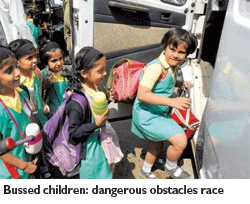The overwhelming majority of India’s 1.40 million schools — especially 1.30 million govern-ment primaries — are bleak, uninviting institutions defined by crumbling classrooms, insanitary conditions, corporal punishment and chronic teacher absenteeism. The country’s 200,000 fee-levying private schools which host almost 40 percent of all school-going children are relatively more inviting. But getting to school — government or private — is becoming an increasingly hazardous and arduous exercise.
In rural India where the law, order and justice machinery is almost non-existent (India’s Central and state governments employ a mere 129 police personnel per 100,000 population cf. 564 in Russia, 1,493 in Egypt, 181 in China and 233 in the US), school-going children are in perpetual danger of kidnap, sexual abuse, rape etc. However, even in relatively better policed metros, getting to school is rapidly becoming a dangerous obstacles race for school — especially girl — children and higher education students.
 For instance in September in Mumbai — India’s commercial capital — four cases of rash driving were booked against school bus drivers; bus atten-dants sexually abusing children as young as four and for inadequately maintained buses and vans without permits bursting into flames. Although under pressure, the Maharashtra state government issued a policy document of School Bus Rules and Regulations, 2011 (under the Maharashtra Motor Vehicles Act, 1989), two and a half years on it has not yet been forwarded to school administrations in Mumbai
For instance in September in Mumbai — India’s commercial capital — four cases of rash driving were booked against school bus drivers; bus atten-dants sexually abusing children as young as four and for inadequately maintained buses and vans without permits bursting into flames. Although under pressure, the Maharashtra state government issued a policy document of School Bus Rules and Regulations, 2011 (under the Maharashtra Motor Vehicles Act, 1989), two and a half years on it has not yet been forwarded to school administrations in Mumbai
As per a government resolution of March 2011, all 103,628 schools in the state were to be sent the policy document containing annexures and prototypes detailing model forms for collection of bus fees; a common standard agreement mandatory for bus owners/contractors permits, as well as the rules to be followed by bussed students for their own safety. However, apart from a standard manual published by the RTO (regional transport office), they have not received any policy document.
“All schools in Maharashtra should have received the policy document containing annexures a long time ago. It is indeed a sad state of affairs that even education inspectors are not aware of it. The main cause of this inordinate delay is the many errors discovered by me in the Marathi translation. The corrections are underway and I have been assured that the schools will receive it within a week or so. The policy document has been put together in such a way so as to ensure that all schools, irrespective of their social/economic standing, implement it uniformly. Many buses are running without permits due to ignorance of the mandatory Common Standard Agreement,” says Indrani Malkani, a transport expert and consul-tant, who was appointed member of the government-appointed committee to draft the School Bus Rules and Regul-ations, based on the success of her model school bus service which she had established in 2002 for the top-ranked Cathedral and John Connon School.
According to Anil Garg, president of the Maharashtra School Bus Owners’ Association, 70 percent of the 9,700 school buses in the state are policy-compliant. “While we maintain that the (school bus) policy is a must, we need a national policy. We have been urging the state government to take action against the 3,340 unlicenced vans transporting students to schools across Mumbai. They routinely flout the maximum permitted capacity rules and also transport students above 12 years of age which is prohibited. Clearly, there’s lack of political will to tackle school vans operating illegally right under the noses of RTO authorities,” says Garg.
The reluctance of the state govern-ment to strictly enforce laws relating to safety of school buses is due to the political influence of the bus owners’ lobby and pervasive corruption within the RTO — the road transport law enforcing agency. Government apathy is compounded by the negligence of parents who seldom bother about checking the antecedents of school bus operators.
Maharashtra School Bus Owners Association president Anil Garg’s computation that the estimated 40 million children of Maharashtra (pop. 112 million) are served by 9,700 licenced buses is eloquent testimony of the education infrastructure of India’s most industrial state. The tragedy is that buses are becoming increasingly unsafe for even the most privileged school-going children.
Sunayana Nair (Mumbai)